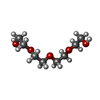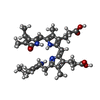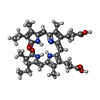[English] 日本語
 Yorodumi
Yorodumi- PDB-7sut: Light harvesting phycobiliprotein HaPE645 from the cryptophyte He... -
+ Open data
Open data
- Basic information
Basic information
| Entry | Database: PDB / ID: 7sut | ||||||||||||
|---|---|---|---|---|---|---|---|---|---|---|---|---|---|
| Title | Light harvesting phycobiliprotein HaPE645 from the cryptophyte Hemiselmis andersenii CCMP644 | ||||||||||||
 Components Components |
| ||||||||||||
 Keywords Keywords | PHOTOSYNTHESIS / phycobiliprotein / antenna / light harvesting / cryptophyte / algae / globin / CALM / CaRSP / phycoerythrin / Hemiselmis | ||||||||||||
| Function / homology |  Function and homology information Function and homology information | ||||||||||||
| Biological species |  Hemiselmis andersenii (eukaryote) Hemiselmis andersenii (eukaryote) | ||||||||||||
| Method |  X-RAY DIFFRACTION / X-RAY DIFFRACTION /  SYNCHROTRON / SYNCHROTRON /  MOLECULAR REPLACEMENT / Resolution: 1.49 Å MOLECULAR REPLACEMENT / Resolution: 1.49 Å | ||||||||||||
 Authors Authors | Rathbone, H.W. / Michie, K.A. / Laos, A.L. / Curmi, P.M.G. | ||||||||||||
| Funding support |  Australia, 3items Australia, 3items
| ||||||||||||
 Citation Citation |  Journal: Commun Biol / Year: 2023 Journal: Commun Biol / Year: 2023Title: Molecular dissection of the soluble photosynthetic antenna from the cryptophyte alga Hemiselmis andersenii. Authors: Rathbone, H.W. / Laos, A.J. / Michie, K.A. / Iranmanesh, H. / Biazik, J. / Goodchild, S.C. / Thordarson, P. / Green, B.R. / Curmi, P.M.G. #1:  Journal: Acta Crystallogr D Biol Crystallogr / Year: 2012 Journal: Acta Crystallogr D Biol Crystallogr / Year: 2012Title: Towards automated crystallographic structure refinement with phenix.refine. Authors: Afonine, P.V. / Grosse-Kunstleve, R.W. / Echols, N. / Headd, J.J. / Moriarty, N.W. / Mustyakimov, M. / Terwilliger, T.C. / Urzhumtsev, A. / Zwart, P.H. / Adams, P.D. #2:  Journal: J Synchrotron Radiat / Year: 2002 Journal: J Synchrotron Radiat / Year: 2002Title: Blu-Ice and the Distributed Control System: software for data acquisition and instrument control at macromolecular crystallography beamlines. Authors: McPhillips, T.M. / McPhillips, S.E. / Chiu, H.J. / Cohen, A.E. / Deacon, A.M. / Ellis, P.J. / Garman, E. / Gonzalez, A. / Sauter, N.K. / Phizackerley, R.P. / Soltis, S.M. / Kuhn, P. #3:  Journal: Acta Crystallogr D Biol Crystallogr / Year: 2004 Journal: Acta Crystallogr D Biol Crystallogr / Year: 2004Title: Coot: model-building tools for molecular graphics. Authors: Emsley, P. / Cowtan, K. #4:  Journal: Acta Crystallogr D Biol Crystallogr / Year: 2011 Journal: Acta Crystallogr D Biol Crystallogr / Year: 2011Title: Overview of the CCP4 suite and current developments. Authors: Winn, M.D. / Ballard, C.C. / Cowtan, K.D. / Dodson, E.J. / Emsley, P. / Evans, P.R. / Keegan, R.M. / Krissinel, E.B. / Leslie, A.G. / McCoy, A. / McNicholas, S.J. / Murshudov, G.N. / Pannu, ...Authors: Winn, M.D. / Ballard, C.C. / Cowtan, K.D. / Dodson, E.J. / Emsley, P. / Evans, P.R. / Keegan, R.M. / Krissinel, E.B. / Leslie, A.G. / McCoy, A. / McNicholas, S.J. / Murshudov, G.N. / Pannu, N.S. / Potterton, E.A. / Powell, H.R. / Read, R.J. / Vagin, A. / Wilson, K.S. #5:  Journal: J Appl Crystallogr / Year: 2007 Journal: J Appl Crystallogr / Year: 2007Title: Phaser crystallographic software. Authors: McCoy, A.J. / Grosse-Kunstleve, R.W. / Adams, P.D. / Winn, M.D. / Storoni, L.C. / Read, R.J. #6:  Journal: J Synchrotron Radiat / Year: 2018 Journal: J Synchrotron Radiat / Year: 2018Title: MX2: a high-flux undulator microfocus beamline serving both the chemical and macromolecular crystallography communities at the Australian Synchrotron. Authors: Aragao, D. / Aishima, J. / Cherukuvada, H. / Clarken, R. / Clift, M. / Cowieson, N.P. / Ericsson, D.J. / Gee, C.L. / Macedo, S. / Mudie, N. / Panjikar, S. / Price, J.R. / Riboldi- ...Authors: Aragao, D. / Aishima, J. / Cherukuvada, H. / Clarken, R. / Clift, M. / Cowieson, N.P. / Ericsson, D.J. / Gee, C.L. / Macedo, S. / Mudie, N. / Panjikar, S. / Price, J.R. / Riboldi-Tunnicliffe, A. / Rostan, R. / Williamson, R. / Caradoc-Davies, T.T. | ||||||||||||
| History |
|
- Structure visualization
Structure visualization
| Structure viewer | Molecule:  Molmil Molmil Jmol/JSmol Jmol/JSmol |
|---|
- Downloads & links
Downloads & links
- Download
Download
| PDBx/mmCIF format |  7sut.cif.gz 7sut.cif.gz | 612.4 KB | Display |  PDBx/mmCIF format PDBx/mmCIF format |
|---|---|---|---|---|
| PDB format |  pdb7sut.ent.gz pdb7sut.ent.gz | 502.1 KB | Display |  PDB format PDB format |
| PDBx/mmJSON format |  7sut.json.gz 7sut.json.gz | Tree view |  PDBx/mmJSON format PDBx/mmJSON format | |
| Others |  Other downloads Other downloads |
-Validation report
| Summary document |  7sut_validation.pdf.gz 7sut_validation.pdf.gz | 5.4 MB | Display |  wwPDB validaton report wwPDB validaton report |
|---|---|---|---|---|
| Full document |  7sut_full_validation.pdf.gz 7sut_full_validation.pdf.gz | 5.5 MB | Display | |
| Data in XML |  7sut_validation.xml.gz 7sut_validation.xml.gz | 50.4 KB | Display | |
| Data in CIF |  7sut_validation.cif.gz 7sut_validation.cif.gz | 64.7 KB | Display | |
| Arichive directory |  https://data.pdbj.org/pub/pdb/validation_reports/su/7sut https://data.pdbj.org/pub/pdb/validation_reports/su/7sut ftp://data.pdbj.org/pub/pdb/validation_reports/su/7sut ftp://data.pdbj.org/pub/pdb/validation_reports/su/7sut | HTTPS FTP |
-Related structure data
| Related structure data |  8el3C  8el4C  8el5C  8el6C  4lmxS S: Starting model for refinement C: citing same article ( |
|---|---|
| Similar structure data | Similarity search - Function & homology  F&H Search F&H Search |
- Links
Links
- Assembly
Assembly
| Deposited unit | 
| ||||||||||||
|---|---|---|---|---|---|---|---|---|---|---|---|---|---|
| 1 | 
| ||||||||||||
| 2 | 
| ||||||||||||
| Unit cell |
|
- Components
Components
-HaPE645 alpha- ... , 2 types, 4 molecules AECG
| #1: Protein | Mass: 8974.020 Da / Num. of mol.: 2 / Source method: isolated from a natural source / Source: (natural)  Hemiselmis andersenii (eukaryote) / References: UniProt: A0A7S0U215 Hemiselmis andersenii (eukaryote) / References: UniProt: A0A7S0U215#3: Protein | Mass: 7795.986 Da / Num. of mol.: 2 / Source method: isolated from a natural source / Source: (natural)  Hemiselmis andersenii (eukaryote) / Strain: CCMP644 Hemiselmis andersenii (eukaryote) / Strain: CCMP644 |
|---|
-Protein , 1 types, 4 molecules BDFH
| #2: Protein | Mass: 18406.949 Da / Num. of mol.: 4 / Source method: isolated from a natural source / Source: (natural)  Hemiselmis andersenii (eukaryote) / References: UniProt: U5T8W0 Hemiselmis andersenii (eukaryote) / References: UniProt: U5T8W0 |
|---|
-Non-polymers , 8 types, 476 molecules 














| #4: Chemical | ChemComp-X2I / ( #5: Chemical | #6: Chemical | ChemComp-CL / | #7: Chemical | ChemComp-AX9 / #8: Chemical | ChemComp-PEB / #9: Chemical | ChemComp-BTB / | #10: Chemical | #11: Water | ChemComp-HOH / | |
|---|
-Details
| Has ligand of interest | Y |
|---|---|
| Has protein modification | Y |
-Experimental details
-Experiment
| Experiment | Method:  X-RAY DIFFRACTION / Number of used crystals: 1 X-RAY DIFFRACTION / Number of used crystals: 1 |
|---|
- Sample preparation
Sample preparation
| Crystal | Density Matthews: 2.36 Å3/Da / Density % sol: 47.95 % |
|---|---|
| Crystal grow | Temperature: 300 K / Method: vapor diffusion, sitting drop / pH: 5.5 / Details: 0.1 M Bis-Tris + 25 % (w/v) PEG 3350 |
-Data collection
| Diffraction | Mean temperature: 100 K / Serial crystal experiment: N |
|---|---|
| Diffraction source | Source:  SYNCHROTRON / Site: SYNCHROTRON / Site:  Australian Synchrotron Australian Synchrotron  / Beamline: MX2 / Wavelength: 0.9537 Å / Beamline: MX2 / Wavelength: 0.9537 Å |
| Detector | Type: DECTRIS EIGER X 16M / Detector: PIXEL / Date: Feb 28, 2020 |
| Radiation | Protocol: SINGLE WAVELENGTH / Monochromatic (M) / Laue (L): M / Scattering type: x-ray |
| Radiation wavelength | Wavelength: 0.9537 Å / Relative weight: 1 |
| Reflection | Resolution: 1.49→115.75 Å / Num. obs: 151716 / % possible obs: 93.4 % / Redundancy: 3.6 % / Biso Wilson estimate: 19.89 Å2 / CC1/2: 0.998 / Rmerge(I) obs: 0.056 / Net I/σ(I): 9.9 |
| Reflection shell | Resolution: 1.49→1.52 Å / Redundancy: 2.2 % / Rmerge(I) obs: 1.117 / Mean I/σ(I) obs: 0.9 / Num. unique obs: 4645 / CC1/2: 0.463 / % possible all: 58.3 |
- Processing
Processing
| Software |
| ||||||||||||||||||||||||||||||||||||||||||||||||||||||||||||||||||||||||||||||||||||||||||||||||||
|---|---|---|---|---|---|---|---|---|---|---|---|---|---|---|---|---|---|---|---|---|---|---|---|---|---|---|---|---|---|---|---|---|---|---|---|---|---|---|---|---|---|---|---|---|---|---|---|---|---|---|---|---|---|---|---|---|---|---|---|---|---|---|---|---|---|---|---|---|---|---|---|---|---|---|---|---|---|---|---|---|---|---|---|---|---|---|---|---|---|---|---|---|---|---|---|---|---|---|---|
| Refinement | Method to determine structure:  MOLECULAR REPLACEMENT MOLECULAR REPLACEMENTStarting model: 4LMX Resolution: 1.49→41.43 Å / SU ML: 0.1629 / Cross valid method: FREE R-VALUE / σ(F): 1.37 / Phase error: 18.3653 Stereochemistry target values: GeoStd + Monomer Library + CDL v1.2
| ||||||||||||||||||||||||||||||||||||||||||||||||||||||||||||||||||||||||||||||||||||||||||||||||||
| Solvent computation | Shrinkage radii: 0.9 Å / VDW probe radii: 1.11 Å / Solvent model: FLAT BULK SOLVENT MODEL | ||||||||||||||||||||||||||||||||||||||||||||||||||||||||||||||||||||||||||||||||||||||||||||||||||
| Displacement parameters | Biso mean: 26.94 Å2 | ||||||||||||||||||||||||||||||||||||||||||||||||||||||||||||||||||||||||||||||||||||||||||||||||||
| Refinement step | Cycle: LAST / Resolution: 1.49→41.43 Å
| ||||||||||||||||||||||||||||||||||||||||||||||||||||||||||||||||||||||||||||||||||||||||||||||||||
| Refine LS restraints |
| ||||||||||||||||||||||||||||||||||||||||||||||||||||||||||||||||||||||||||||||||||||||||||||||||||
| LS refinement shell |
|
 Movie
Movie Controller
Controller


 PDBj
PDBj








